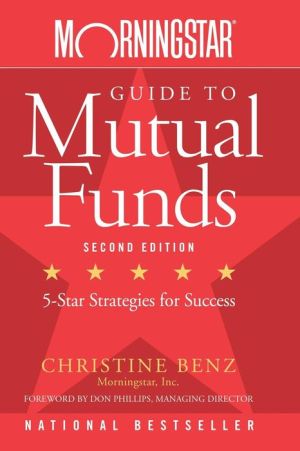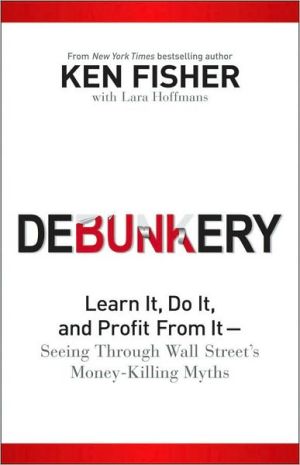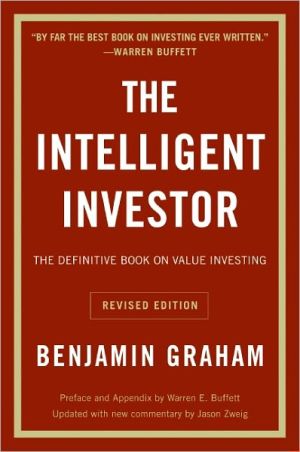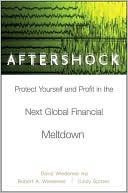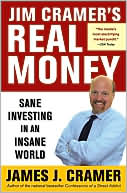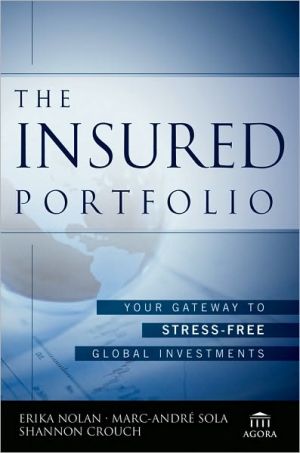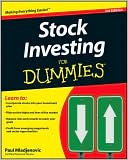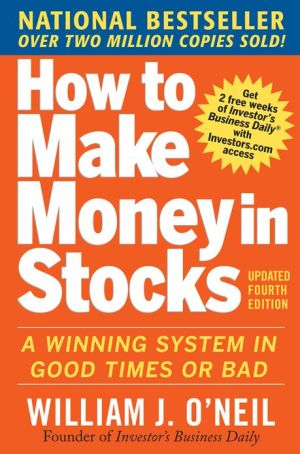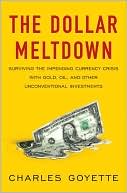Morningstar Guide to Mutual Funds: Five-Star Strategies for Success
GUIDE TO MUTUAL FUNDS\ SECOND EDITION\ "Picking actively managed mutual funds is no mean challenge. And as the recent era underscores, past performance is of little help. The Morningstar Guide to Mutual Funds helps cut through the fog with a solid volume of constructive information. The central message—'truly diversify, keep it simple, focus on costs, and stick with it'—is not only timeless, it is priceless."\ —John C. Bogle, founder and former CEO, The Vanguard Group\ "Successful investors...
Search in google:
Praise for MorningstarGuide To Mutual FundsSecond Edition"Picking actively managed mutual funds is no mean challenge. And as the recent era underscores, past performance is of little help. The Morningstar® Guide to Mutual Funds helps cut through the fog with a solid volume of constructive information. The central message—'truly diversify, keep it simple, focus on costs, and stick with it'—is not only timeless, it is priceless."—John C. Bogle, founder and former CEO, The Vanguard Group"Successful investors know they must do their own due diligence. Morningstar has done much of that homework in this guide. Leave it to Morningstar to get it right, offering smart ways to pick, build, and monitor a portfolio. It's a commonsense guide that should grace every investor's shelf."—Ted David, Senior Anchor for CNBC Business Radio"There's nothing Morningstar doesn't know about mutual funds. And at last, for ready reference, there's a book. You'll find everything here you need to know about managing fund investments, inside or outside a 401(k)."—Jane Bryant Quinn, Newsweek columnist and author of Making the Most of Your Money
Morningstar Guide to Mutual Funds\ \ By Christine Benz \ John Wiley & Sons\ ISBN: 0-471-71832-7 \ \ \ Chapter One\ Know What Your Fund Owns \ Most of us wouldn't buy a new home just because it looked good from the outside. We would do a thorough walk-through first. We'd examine the furnace, check for a leaky roof, and look for cracks in the foundation.\ Mutual fund investing requires the same careful investigation. You need to give a fund more than a surface-level once-over before investing in it. Knowing that the fund has been a good performer in the past isn't enough to warrant risking your money. You need to understand what's inside its portfolio-or how it invests. You must find out what a fund owns to know if it's right for you.\ The stocks and bonds in a fund's portfolio are so important that Morningstar analysts spend a lot of their time on the subject; news about what high-profile fund managers are buying is a constant source of e-mail chatter in the office. Our analysts examine fund portfolios of stocks or bonds, talk with the managers about their strategies in picking those holdings, and check on recent changes to the portfolio. Knowing what a fund owns helps you understand its past behavior, set realistic expectations for what it might do in the future, and figure out how it will work with the other investments you might own.\ At the most basic level, a fund can own stocks, bonds, cash (usually money market securities), or a combination of the three. (Funds might alsoown other securities, including other funds and stock/bond hybrid securities, but let's stick with the basics for now.) If it invests in stocks, it could focus on U.S. companies or venture abroad. If the fund owns U.S. companies, it might invest in giants such as General Electric or Microsoft or seek out tiny companies that most of us have never heard of. If a fund invests in bonds, it could focus only on those issued by companies with rock-solid finances and a high probability that they'll make good on their debts or it could venture into higher-yielding bonds issued by firms with shaky future prospects. How a manager chooses to invest your money has a big impact on performance. For example, if your manager devotes much of the portfolio to a single volatile area such as technology stocks, your fund may generate high returns at times, but there's also a greater likelihood that you'll lose money at other times. Stocks have historically generated higher returns than cash or bonds. Because you take the least risk when you invest in cash, those securities also tend to generate lower returns than you'd get with stocks or bonds.\ A fund's name doesn't always reveal what a fund owns because funds often have generic handles. Take the intriguingly named Janus Olympus and American Century Veedot funds. If you were to skim over only their names, you would be hard-pressed to glean that the former focuses on mid- and large-sized companies that are growing quickly (think Yahoo! and eBay), whereas the latter is a fund that uses computer models to help direct investments to whatever type of stocks look like they could be strong performers in the future.\ Nor will a fund's prospectus-a legal document filed with the Securities and Exchange Commission (SEC) that lays out the basics of an investment-necessarily be of much help in determining what a given fund is up to. While fund prospectuses do include information about who's running a fund and its basic investment parameters, prospectuses are typically written in very broad terms to give managers the latitude to invest as they see fit.\ In their prospectuses, funds are also required to state their objectives-a one- or two-word description of their basic goals, such as "Growth," "Equity-Income," "Growth & Income," and so on. You'd think these so-called prospectus objectives might help you sort out who's doing what, but in reality funds with the same prospectus objectives can be pursuing radically different investment approaches and end up with very different returns. For example, both Aegis Value Fund and AllianceBernstein Large Cap Growth have prospectus objectives of "Growth." But the former focuses on tiny, budget-priced stocks, whereas the Alliance fund focuses on fast-growing stocks of large companies. When the bear market struck between 2000 and 2002, the Aegis fund returned 18% annually, whereas the Alliance fund lost 26% over that stretch.\ Understanding The Morningstar(r) Style Box(tm)\ A desire to help investors choose funds based on what they really own-instead of on what funds call themselves, how they classify themselves, or how they've performed recently-was precisely what inspired Morningstar to develop its investment style box in the early 1990s. The style box provides a quick visual summary of a given fund's portfolio, showing you, using a nine-box investment-style grid, where most of your fund's portfolio is invested. (To check out a fund's current style box, go to Morningstar's Web site, morningstar.com, and type in a fund's name or ticker.) While investors needn't own a fund from each and every square of the style box, the tool can help you know whether your portfolio is diversified. If all of your funds are huddled in a single corner of the style box, that's a tip-off that you'll probably want to spread your bets around more. The style box also helps investors keep track of whether a fund has changed its approach, because we update each fund's style-box placement every time we receive a new portfolio. If a fund that you bought to bring your portfolio exposure to the fast-moving technology and telecom industries is suddenly delving into the securities of small manufacturing firms, you'll see that change reflected in your fund's style-box placement.\ For stock funds, the style box isolates two key factors that drive its performance: the size of the stocks the fund invests in and the type of companies it buys-rapidly growing companies for which investors are willing to pay a pretty penny, slower growers that trade at lower prices, or a combination of the two (see Figure 1.1). Those two factors-company size and investment style-form the two axes of the stock, or equity, style box. For bond funds, the style box focuses on the two key determinants of bond-fund behavior: a fund's sensitivity to changes in interest rates and the credit quality of the bonds in which it invests. Those two factors form the axes of the bond-fund style box (see Figure 1.2). Once we have determined the size and investment-style coordinates for a stock fund and the interest-rate sensitivity and credit-quality coordinates for a bond fund, we can use our nine-square style box grid to show investors-visually-where their fund lands.\ Using the Stock-Fund Style Box\ To figure out which square of our stock style box a fund portfolio lands in, we first analyze each and every stock in that portfolio. We begin by grouping each stock in a portfolio into one of seven regions: the United States, Latin America, Canada, Europe, Japan, Asia ex-Japan, and Australia/New Zealand.\ Once we've placed a stock within one of our regional zones, we then go on to evaluate how it stacks up relative to other firms within that same zone. We start that process by determining whether a security is small, medium, or large within its region. In investing parlance, stock size is often called market capitalization, or market cap. Market cap sounds like a technical term, but it's not particularly hard to understand-essentially, it's the current dollar value of all of a given company's stock shares. So if a stock is selling for $30 and there are a million shares of it floating around in the market, the company has a market cap of $30 million. We consider companies whose market caps land within the largest 70% of their region to be large cap; the next 20% are midcap; and the smallest 10% are small caps. Although small-cap stocks only account for 10% of each region's market, there are actually many more of them than there are large-cap companies.\ Having determined a security's regional and size classification, we turn our attention to its investment style. Investing aficionados typically group stocks into one of two major buckets-growth stocks or value stocks-and often identify themselves as growth investors or value investors. Understanding the difference between the two styles is critical to understanding what makes a fund tick.\ Growth stocks typically enjoy strong growth in earnings or revenues because they've got a hot new product or service. Because the market expects good things from these fast growers, and earnings growth usually drives a higher share price, investors are willing to pay more for the shares than they will pay for slower growers.\ Value stocks, conversely, look like growth stocks' less successful cousins. These companies' earnings are usually growing slowly, if at all, and they often operate in industries that are prone to boom-and-bust cycles. So why does anyone bother with these underachievers? The answer is, because they're cheap. Fund managers who focus on value stocks are willing to put up with lackluster earnings growth because they think the market is being overly pessimistic about the company's future. Should things turn out better than the market thinks, the bargain-hunting fund stands to profit.\ Some companies display a mixture of both growth and value characteristics-we call these core stocks. Many pharmaceuticals stocks currently fit the core designation. Historically, these firms have been terrific growers, as new drug launches and stepped-up demand from aging baby boomers have driven high profits and, in turn, high stock prices. But lately, problems with a few high-profile drugs as well as chatter about lackluster new products and drug-price controls have depressed the prices for drug stocks.\ To help classify a stock as growth, value, or core, we look at 10 separate factors, including dividend yields, price/earnings ratios (a company's current share price divided by its earnings), and historical and projected earnings growth.\ Once we have classified each stock's investment style, we then classify the entire portfolio, based on which square of our style box most of its stocks land in. Securities that the manager has weighted the most heavily will play a bigger role in determining a fund's investment style than will smaller positions. For example, a stock that takes up 10% of a portfolio will be a much bigger determinant of a fund's style-box positioning than will a stock that takes up 2%.\ Funds that devote most of their assets to stocks with strong growth characteristics will land in the growth column of our style box, while those with a higher concentration of value stocks will land in our value column. Funds that hold both growth and value stocks, or those that focus mainly on so-called core stocks, will land in the blend column of our style box.\ Using the Bond-Fund Style Box\ The bond-fund style box, like the stock style box, is also a nine-square grid. Whereas the stock style box has a growth/value axis and a small/large axis, however, the two axes of the bond style box are interest-rate sensitivity (or duration, which we define in the following discussion) and credit quality. Unlike the equity style box, we arrive at a bond portfolio's style box not by drilling into each and every security, but instead by measuring the average weighted characteristics of the portfolio. (Average weighted means that our calculation gives greater weight to a portfolio's big positions than its small ones.)\ Knowing a bond fund's interest-rate sensitivity helps you determine how much it will react when interest rates go up or down. When interest rates go up, that typically depresses the price of already-existing bonds, particularly those with longer maturities, because investors would rather buy a newer bond with a higher interest payment, or yield, than get locked into a long-term bond that happens to have a lower yield. The reverse happens when interest rates go down. Investors would rather buy an existing bond with a higher yield than they would opt for a new, lower-yielding bond. That demand drives up the price of existing bonds.\ To help measure a bond fund's interest-rate sensitivity, we rely on a figure called duration. Duration is a pretty knotty concept; it's defined as the average time it takes a bondholder to receive the interest and the principal payments from a bond. Because it's a measure of time, duration is expressed in years. As a general rule of thumb, every one-percentage-point change in interest rates will cause a fund to gain or lose the amount of its duration. For example, a bond fund with a duration of 8 years is apt to lose 8% of its value if interest rates go up by one percentage point. For the purpose of our fixed-income style box, we classify bond funds with average durations of less than 3.5 years as short term, those with durations between 3.5 and 6 years as intermediate term, and those with durations of 6 years or more as long term. (We use a slightly different framework for classifying municipal-bond funds' interest-rate sensitivity. Municipal bond funds with durations of less than 4*5 years are short; those with durations between 4.5 and 7 years are intermediate term; and those with durations of 7 years or more are long.)\ A bond portfolio's average duration helps us plot a fund on the horizontal axis of the style box. To determine its placement on the vertical axis, we examine the average credit quality of the bonds in the portfolio. Third parties such as Moody's and Standard & Poor's assign credit qualities to bonds. By looking at a bond's credit quality, you can get a sense of how likely it is that a bond's issuer will be able to continue making its interest payments to bondholders-an important consideration if you're looking for regular income, as many bond investors are. Morningstar considers bond funds with average credit qualities of AAA or AA to be high quality, those with credit qualities that are lower than AA but greater than or equal to BBB to be of medium quality, and those with average credit qualities below BBB to be low quality.\ Armed with both a portfolio's interest-rate sensitivity and its average credit quality, we can plot that fund in our style box.\ Using Morningstar's Category System\ Despite the usefulness of the Morningstar style box, it's just a snapshot of the fund's most recent portfolio. When you are selecting a fund to play a particular role, such as adding a high-quality bond fund because you want stability and regular income, you want to be confident that it actually has played that role over time. That's what we have in mind when we plug funds into Morningstar categories. We assign funds to categories based on the past three years' worth of style boxes. (Fund firms are required to provide shareholders with a list of their funds' portfolio holdings every quarter, but some fund shops make their portfolios available even more frequently than that.) A single portfolio could reflect a temporary aberration-maybe the fund's holdings have been doing really well, so they have grown from small- to mid-cap as stock prices have gone up. But because a fund's category assignment is based on three years' worth of portfolios, it gives you a better handle on how the fund typically invests.\ You'll see that our category system for U.S. and foreign-stock funds is closely related to our style box. On the U.S. stock side, we have categories corresponding with each of the nine squares of the style box, ranging from large value in the upper left corner to small growth in the lower right corner. Similarly, we have five style-based categories for diversified foreign-stock funds (i.e., those that don't focus on a single region), ranging from foreign large-value to foreign small/mid-growth. (Because there aren't quite as many foreign-stock funds in the U.S. as there are domestically focused funds, we don't have separate foreign-stock categories corresponding with all nine squares of the style box.) We also carve out some categories for specialized stock funds. To name a few, there are categories for health-care offerings, Japan funds, and energy funds. Morningstar slots funds into about 50 categories (see Figure 1.3).\ (Continues...)\ \ \ \ \ Excerpted from Morningstar Guide to Mutual Funds by Christine Benz Excerpted by permission.\ All rights reserved. No part of this excerpt may be reproduced or reprinted without permission in writing from the publisher.\ Excerpts are provided by Dial-A-Book Inc. solely for the personal use of visitors to this web site. \ \
ForewordvAcknowledgmentsixIntroductionxiPart 1How to Pick Mutual Funds1Chapter 1Know What Your Fund Owns3Chapter 2Put Performance in Perspective18Chapter 3Understand the Risks27Chapter 4Get to Know Your Fund Manager39Chapter 5Keep a Lid on Costs68Part 2How to Find Ideas for Your Portfolio81Chapter 6Find the Right Core Stock Funds for You83Chapter 7Move Beyond the Core: Using Specialized Stock Funds113Chapter 8Find the Right Core Bond Fund for You134Chapter 9Move Beyond the Core: Using Specialized Bond Funds148Part 3How to Build a Portfolio159Chapter 10Match Your Portfolio to Your Goals161Chapter 11Put Your Portfolio Plan into Action169Chapter 12Simplify Your Investment Life182Chapter 13Be Savvy When Seeking Advice191Part 4How to Monitor Your Portfolio197Chapter 14Schedule Regular Checkups199Chapter 15Know When to Sell207Chapter 16Keep a Cool Head in Turbulent Markets218Part 5More on Mutual Funds: Frequently Asked Questions229Recommended Reading277Other Morningstar Resources281Index283
